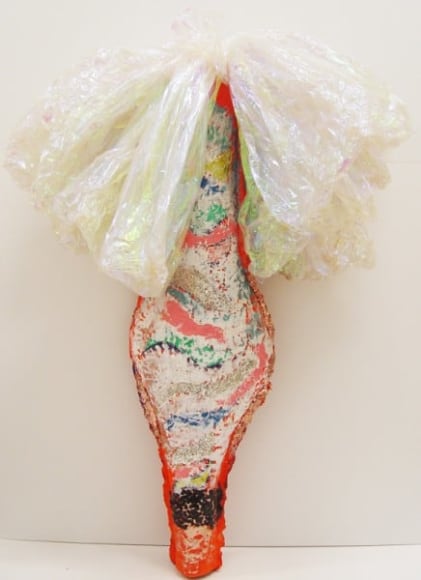Lynda Benglis

Lagniappe, 1978
In the summer of 1964, Lynda Benglis made her way to New York on a bus filled with anti-Jim Crow activists on their way home from Mississippi. The young artist was described “as a very canny young woman from Louisiana, Tulane BFA in hand” when she arrived in New York.
Lynda Benglis lost her Southern accent as fast as she could and enrolled at the Brooklyn Museum Art School. After a few months it seemed Lynda Benglis knew almost everyone in the art world. Her blunt manner must have been balanced by considerable charm if as the story goes she really got away with telling David Hockney at one of his openings that his drawings were good but that he ought to forget about his paintings. Lynda Benglis also recommended to Dan Flavin who was still making painted boxes with light-bulbs sticking out that maybe he could lose the boxes which he eventually did.
The New York art world was smaller then and according to Lynda Benglis “nobody was going to these openings”. As a result it was relatively easy for a smart and ambitious young woman to meet the people who mattered. After a semester at the Brooklyn Museum Art School, Lynda Benglis decided it had outlived its usefulness and she began making her way as an artist. By the latter part of the 1960′s, she was investigating process-oriented paintings in wax on board and working part-time for Klaus Kertess at the Bykert Gallery where the artist recalled “I had to bring my own typewriter”.
Later, Lynda Benglis worked as a waitress which brought in enough money to buy the quantities of latex paint needed to make her first poured works. These works were described as breakthrough pieces. One of these works, recently re-exhibited at the Locks Gallery in Philadelphia, is titled Odalisque: Hey Hey Frankenthaler dated 1969.
That same year Lynda Benglis was invited to participate in “Anti-Illusion: Procedures/Materials” conceived by the Whitney Museum of American Art and curators Marcia Tucker and James Monte. Lynda Benglis proposed a big “spill” work called Contraband. But there was a hitch when she explained that her bright colors would pop out in a brilliant way against the Museum’s black stone floor. The curators realized that while Lynda Benglis might have been as interested in procedures and materials as Robert Morris, Richard Serra and the rest, she was also just as interested in illusion which was a no-no for the anti-realist prejudices of the contemporary Whitney.
Featured works
Biography
At least that’s how Lynda Benglis remembers it. According to Tucker, the work was just too big unlike the artist’s original proposal. As a compromise, Lynda Benglis later told critic Carter Ratcliff “They offered to build a ramp for it near the entrance to the Museum to sort of get it off to one side.” But rather than allow her work to be marginalized, Lynda Benglis withdrew it from the show.
The catalogue had already gone to press, so her work remained which has occasionally led to its being discussed as if it had been in the exhibition. Just after “Anti-Illusion” opened, Lynda Benglis showed a similar latex work at Bykert, Bounce, 1969. It was a “strange and startling colored spread” that was seen in an Artforum magazine review as “a kind of painting entirely freed from an auxiliary ground or armature.”
Several iconic images come to mind when one thinks of Lynda Benglis. Her decorative gilded knots of the late 1970′s and of course the notorious ad that graced ArtForum in November 1974. The image of Lynda Benglis sporting a dildo was so outrageous to some that it caused an irreparable rift among the magazine’s editors.
But for many viewers, the first image the name Lynda Benglis conjures will be one of her aforementioned “spills” which were expanses of multicolored latex paint poured on the floor in the late 1960′s. In the continuing, unlikely art-theoretical gyrations of contemporary critics, such works have been seen as a development stemming from the Abstract
Expressionism of Jackson Pollock and the poured paintings of the Color Field movement as if the endeavors of Lynda Benglis merited a place in some logical art historical stream of stylistic consciousness instead of being another Dadaist inspired assault on art.
Two decades after the Whitney’s “Anti-Illusion: Procedures/Materials” show, the Museum would make up for the absence of Lynda Benglis by including her in its 1990 survey “The New Sculpture 1965-75: Between Geometry and Gesture.” The first big one-person show of Lynda Benglis would take place in 1991 at the Paula Cooper Gallery. Lynda Benglis, Eva Hesse, Richard Serra and Richard Van Buren were included in a Life magazine article called “Fling, Dribble and Drip”. This continued Life’s publicizing of a hyped avant-garde deemed newsworthy since their earlier article on “Jack the Dripper” about Jackson Pollock.
Source includes:
Barry Schwabsky, Artforum, October 2002
Biography from the Archives of AskART


